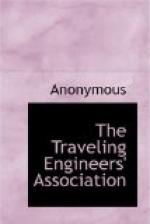146. Q. If the distributing valve release pipe breaks, what will be the effect?
A. The holding feature of the brake will be lost; that is, the locomotive brake will release when the automatic brake valve is moved to either release or holding position, the same as with the old G-6 equipment.
147. Q. If the release pipe is broken and not plugged, can the independent brake be applied?
A. Yes, by placing the brake valve handle in quick-application position the brake will apply, but there will be a waste of air through the broken pipe, and the brake will release when the brake valve is returned to lap position.
148. Q. If the brake cylinder pipe breaks, can the locomotive brake be applied?
A. This depends on where the pipe breaks; if between the cut-out cock and any one of the brake cylinders, close the cut-out cock to that cylinder, and the other cylinders may be used. But if the pipe breaks at the distributing valve, the locomotive brake will be lost.
149. Q. If the brake pipe connection to the distributing valve breaks, what should be done?
A. Plug the end from the brake pipe; the locomotive brake must now be released by placing the independent valve in release position.
150. Q. If the brake pipe connection to the distributing valve breaks and is plugged, can the locomotive brake be operated?
A. The independent brake may be applied and released in the usual manner, but the automatic brake will be lost for service braking.
TYPE K TRIPLE VALVE
151. Q. On what is this type of triple valve designed to operate?
A. On freight equipment cars only.
152. Q. Explain the operation of the “K” triple valve.
[Illustration: Fig. 13. Full Release and Charging Position.]
A. When air is admitted to the brake pipe it is free to enter the triple at “a” (see Fig. 13) and flow through the passage “e” to chamber “f”, thence through port “g” to chamber “h” in front of the triple valve piston 4. Pressure forming in chamber “h” will force the piston to the left until its packing ring uncovers the feed groove “i” in the bushing, thus creating a communication between chamber “h” and the slide valve chamber. Brake pipe air will now be free to flow past the piston to the slide valve chamber and out at “R” to the auxiliary reservoir. Air will continue to feed through the groove “i” until the auxiliary reservoir and brake pipe pressures are equal, and it is then we say that the brake is fully charged. Brake pipe air entering chamber “a” will lift the check valve 15, and charge chamber “Y” to brake pipe pressure. When a gradual reduction of brake pipe pressure is made, as in a service application of the brakes, the pressure being reduced in chamber “h”, auxiliary reservoir pressure will move the piston 4 toward service position. (See Fig. 14.) The first movement of the piston closes the feed




